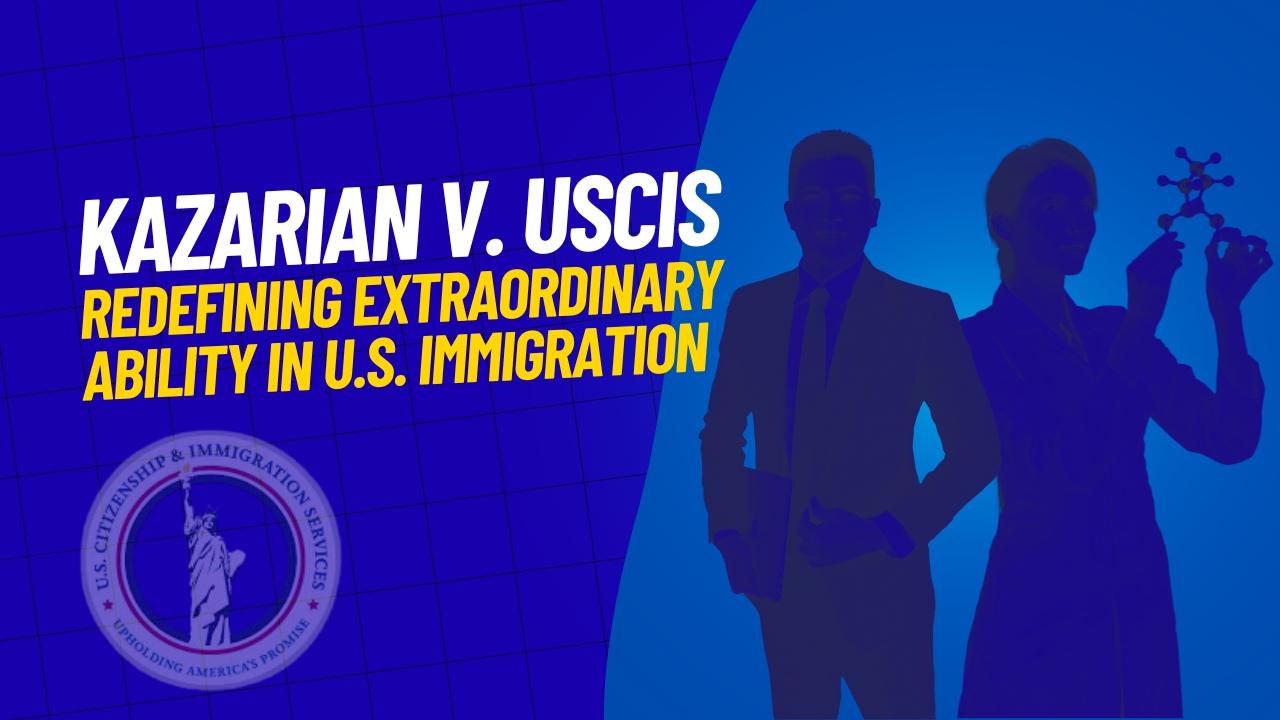What does it really mean to be “extraordinary” for immigration purposes and who decides how we prove it? For years, EB-1A petitions often felt like a shell game: petitioners tried to meet the regulation’s listed criteria while adjudicators quietly pressed for something more. In Kazarian v. USCIS, 596 F.3d 1115 (9th Cir. 2010), the Ninth Circuit stepped in, not to lower the bar, but to put the bar where the regulation said it belongs. The result is the now-familiar two-step review that structures EB-1A adjudication to this day.
Why Kazarian mattered
Poghos Kazarian, a theoretical physicist from Armenia, sought EB-1A classification based on publications, memberships, and related achievements. USCIS denied; the Administrative Appeals Office (AAO) affirmed; the district court granted summary judgment for the government. On appeal, the Ninth Circuit affirmed the outcome but reframed the method. The court held that adjudicators may not add extra, off-regulation demands when deciding whether evidence satisfies the enumerated criteria (the “counting” phase). At the same time, the court recognized a separate, qualitative appraisal of whether the total record proves sustained acclaim and that the person is in the small percentage at the very top of the field (after the criteria are met). See Kazarian, 596 F.3d at 1121–22.
The two-step review, stated plainly
Step One: Counting
The first step requires the petitioner to demonstrate either (a) a one-time, major, internationally recognized award or (b) evidence satisfying at least three of the ten regulatory criteria outlined in 8 C.F.R. § 204.5(h)(3). In Kazarian, the Ninth Circuit emphasized that adjudicators should not impose additional, unlisted sub-tests. See Kazarian, 596 F.3d at 1122–23.
Step Two: Final merits determination
Once the petitioner meets the threshold criteria, the second step involves evaluating the total body of evidence to determine whether the petitioner has achieved sustained national or international acclaim and is recognized as being at the very top of their field. This stage involves assessing the quality, independence, selectivity, and impact of the evidence, considering factors like the prestige of awards, independence of citations, leadership roles, influence within the industry, adoption in professional standards, and credible media recognition. It prevents hidden gatekeeping at Step One while preserving a disciplined, holistic look at excellence at Step Two.
From court opinion to agency playbook
USCIS quickly adopted the two-step framework outlined in Kazarian. In 2010, a policy memorandum updated the Adjudicator’s Field Manual, directing officers to follow this two-part analysis for EB-1 and similar classifications: (1) first, confirm that the petitioner meets the plain-text criteria or holds a one-time major award; and (2) second, conduct a final merits determination, assessing the entire record. This approach was later codified in the USCIS Policy Manual (Vol. 6, Pt. F, Ch. 2), and AAO decisions now consistently apply the “count first, then weigh” methodology.
While this two-step structure may seem self-evident now, its significance lies in the clarity it provides. Prior to Kazarian, these inquiries were often conflated, leading to inconsistent decision-making. The decision’s lasting impact was to separate the two stages, ensuring a more transparent and structured process.
How the shift changed practice
Clearer Threshold
Petitioners are now less likely to face shifting standards within individual criteria. The focus is on the text: authorship is simply authorship, judging is just judging, and membership is membership—without additional, subjective requirements not specified in the regulation. This change represents a significant win for the rule of law and improves the drafting process by providing clearer guidelines.
Tougher Final Evaluation
The real challenge now lies in Step Two. While two petitions may meet the same number of criteria, they may still differ significantly in their final assessment. The focus has shifted from whether the achievements exist to what those achievements signify in the field. Key questions include: How selective was the award? Who is citing the work, and are those citations independent? Did the work lead to changes in industry standards, products, or policies? How widely adopted was the petitioner’s contribution beyond their immediate circle?
For practitioners, this shift rebalances the approach. There is now less emphasis on proving that a criterion is met and more emphasis on demonstrating the broader impact of the petitioner’s work.
Strengths and the cracks in the two-step model
Strengths (fairness and transparency)
The two-step model brings greater clarity to the adjudication process. Each step is clearly defined, so it’s easier to see why a case succeeded or failed. This transparency reduces the risk of hidden gatekeeping at the threshold, where subtle changes could disproportionately influence the outcome. It also allows petitioners to present their evidence in a way that aligns with how adjudicators evaluate cases: first by confirming the evidence fits the criteria, then by assessing its overall merit.
Cracks (subjectivity and variability)
However, Step Two introduces a significant problem. The subjective nature of the qualitative judgment leaves room for variability across cases. There are unwritten benchmarks, such as prestige tiers, unspoken citation expectations, or assumptions about the selectivity of conferences, that differ across disciplines and adjudicators. This means that what constitutes “top of the field” can vary greatly depending on the individual reviewing the case. A jazz guitarist, a quantum cryptographer, and a climate-policy analyst might all be judged by different standards, despite having comparable accomplishments. The lack of clear, field-sensitive guidelines exacerbates this issue, leading to inconsistent outcomes. Furthermore, judicial deference to the agency’s discretion in weighing the evidence makes it difficult to overturn Step Two denials unless they clearly disregard key evidence or fail to explain their reasoning adequately.
In theory, the two-step model promotes fairness by creating a structured process. In practice, however, it can introduce new challenges, particularly at Step Two. Whether the two-step model ultimately enhances fairness or creates additional hurdles largely depends on how consistently and transparently Step Two is executed and explained.
Building EB-1A cases after Kazarian
1) Write to the sequence. Keep Step One tight and literal
In Step One, focus on meeting the regulatory criteria with precision. Clearly map each piece of evidence to a specific criterion or a one-time major award, avoiding unnecessary explanations or embellishments. This phase should strictly adhere to the regulation’s requirements, no extra commentary. Save the narrative for Step Two, where you’ll have the opportunity to explain the significance of your achievements.
2) Lead with independent proof
Step Two’s evaluation centers on the broader impact of your work, so prioritize third-party verification. The final merits determination relies heavily on external, verifiable sources such as:
- Selective awards with documented acceptance rates
- Independent citations (avoid self-citations or citation chains)
- Leadership roles (keynote speeches, plenary sessions)
- Influence in standards bodies or policy-making
- Commercialization and widespread adoption of your work (e.g., software, methods, datasets)
These indicators demonstrate not just accomplishment, but also how your contributions have been recognized and validated by others in your field.
3) Calibrate expert letters
Expert letters can strengthen your case, but they must be carefully selected and crafted. Choose experts who are well-respected in your field and, when possible, independent from your direct network. Replace general adjectives with specific data and metrics: for example, instead of simply saying an award is “prestigious,” mention its acceptance ratio or provide evidence of its selectivity. Highlight measurable outcomes such as performance improvements, widespread adoption, or revisions to standards. Complement these letters with corroborative evidence such as program notes, release logs, or policy documentation that support the expert’s claims.
4) Use comparable evidence well
When the standard criteria don’t quite fit your achievements, use comparable evidence strategically. The regulations allow you to submit analogous contributions if they are of similar significance to those outlined in the criteria. For example, managing a popular open-source software library can be considered an “original contribution of major significance” if you can demonstrate cross-industry use, governance roles, and the widespread impact of the library. Be sure to draw explicit parallels between your evidence and the regulation’s listed criteria.
5) Pre-empt the “so what?” RFE
Anticipate potential RFEs by including a one-page impact overview early in your petition. This summary should clearly outline the field’s challenges, your solution, and the independent validation of your work. Explain the concrete outcomes of your contributions. This overview can act as a guide for adjudicators, linking your exhibits to the overarching narrative. If Step Two is where the decision will be made, give the officer a clear map of your achievements and their broader implications.
What recent decisions teach (and what they can’t)
AAO decisions frequently refer to the two-step framework, outlining how outcomes are determined at both stages. Common patterns emerge: Step One is usually satisfied, but Step Two often falls short in terms of independence, selectivity, or field-shaping impact. While these decisions are non-precedential, they offer valuable insight into how adjudicators assess “top of the field” across various domains, whether in academic science, applied engineering, or creative industries. However, they don’t provide a clear formula for success; instead, they highlight what has swayed adjudicators in previous cases and what has failed to do so.
Fairness or friction? A candid assessment
The most balanced view is also the most restrained: Kazarian enhanced integrity at the threshold and introduced greater structural discipline, but it also solidified a high-discretion final stage. This discretion is not inherently problematic, elite status is inherently context-dependent, but it demands careful reasoning and field-specific knowledge to ensure consistent outcomes. When Step Two is executed properly, truly exceptional petitioners, even those with non-traditional paths, can be recognized for their achievements. However, when done poorly, this qualitative stage can resemble the previous subjective threshold games under a different guise.
Closing thought
Kazarian didn’t make the EB-1A process easier, it made it clearer. The regulatory text now clearly dictates what evidence can be considered, while the final merits inquiry determines how that evidence demonstrates elite status. This may feel like a trade-off, more structure in exchange for more discretion, but for both practitioners and petitioners, it’s also an opportunity: to present a precise, verifiable story of sustained recognition and top-tier influence, one that both legal decision-makers and informed readers can confidently follow.

